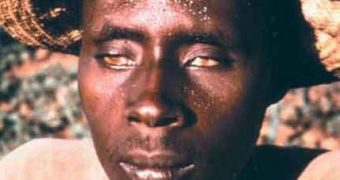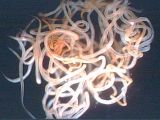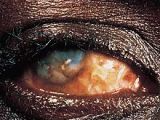In some western African villages, most of the elders die blind. This is the result of onchocerciasis or river blindness provoked by the female black flies (Simulium) which transmit the disease through their bite.
These flies reproduce in the fast flowing rivers. Fortunately, river blindness is not so easy to catch like other tropical diseases. It is not a menace for city dwellers nor for passing visitors.
Those infected get blind only after repeated infections along many years. But even so, river blindness is a terrific tropical disease, that kills millions of people and 18 millions carry the parasite worm.
In some regions in Middle East and Central and South America reaches uncontrollable proportions, but the most affected are the populations from Equatorial Africa, living near infested rivers, where in some villages all the inhabitants have the disease.
About 126 millions worldwide are in peril of catching the disease and the number of partially to totally blinded persons is 1-2 millions. When an infected fly bites a person and sucks his/her blood, it unwittingly deposes the larvae of the parasite worm named Onchocerca volvulus. Under the human epidermis, the larvae slowly grow developing in 60 cm (24 inch) long worms.
After being fecundated, the females produce little larvae named microfilarias, some millions over 8-12 years.
They must be sucked by a fly (inside which they further develop) to continue the cycle.
Most of the larvae gather in the epidermis, but they can reach the eye.
One victim can carry up to 200 million larvae, so numerous that they can be detected in small epidermis probes, where hundreds of microfilarias can be observed under microscope. The victims experience a great deal of sufferance.
Over the years, the skin thickens and makes a crust, often accompanied by depigmented patches (this skin is describes as crocodile skin, lizard skin, leopard skin).
The unbearable itches made many commit suicide. The blindness is triggered when the larvae reach the eye.
In many poor rural African areas, this blindness is regarded as a divine punishment and the victims are considered a burden. The young won't be able to marry. Many settlements in the zones haunted by river blindness are abandoned. These may be fertile areas, so this causes here poverty and hunger.
In the '70s a huge effort was carried out to extirpate the flies from a large area, disrupting the reproductive cycle of the parasite. Tonnes of biodegradable larvicides were spread over huge areas, in fast flowing rivers, as the fly's larvae need these high oxygen level waters to develop.
The disease was eliminated on 80 % of the infected zones of the countries involved in this program. In 1987, American researchers developed a drug named mectizan (ivermectin) that destroys the worms inside the body.
To stop the disease's evolution, a person must take a sole dosis (one or two tablets) each year. The mectizan does not kill the adult worms found inside the body but the larvae, and impedes the adults to further produce larvae.
This fact impedes the disease's evolution and the transmission process from one individual to another is slowed. The drug is also an antidote for the incipient cornea lesions and impedes the aggravation of others.
But it can not heal old eye lesions and can not reestablish sight in those already blind.
Till 1995, 31 million tablets had been distributed, despite the lack of infrastructure, civil war and bureaucracy from many affected countries. 25 million hectares were recovered for agriculture.

 14 DAY TRIAL //
14 DAY TRIAL // 

